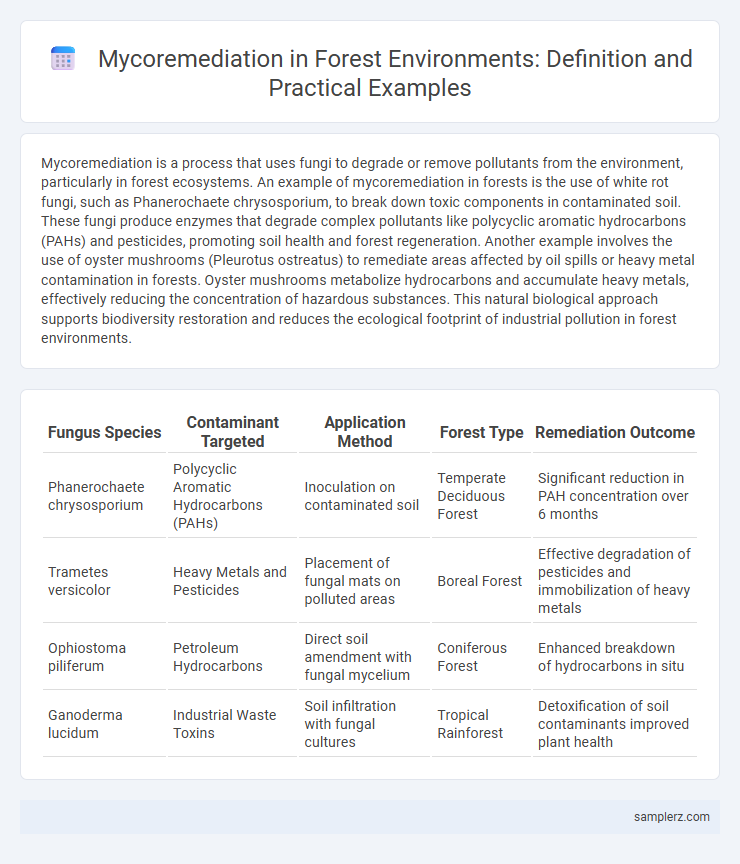Mycoremediation is a process that uses fungi to degrade or remove pollutants from the environment, particularly in forest ecosystems. An example of mycoremediation in forests is the use of white rot fungi, such as Phanerochaete chrysosporium, to break down toxic components in contaminated soil. These fungi produce enzymes that degrade complex pollutants like polycyclic aromatic hydrocarbons (PAHs) and pesticides, promoting soil health and forest regeneration. Another example involves the use of oyster mushrooms (Pleurotus ostreatus) to remediate areas affected by oil spills or heavy metal contamination in forests. Oyster mushrooms metabolize hydrocarbons and accumulate heavy metals, effectively reducing the concentration of hazardous substances. This natural biological approach supports biodiversity restoration and reduces the ecological footprint of industrial pollution in forest environments.
Table of Comparison
| Fungus Species | Contaminant Targeted | Application Method | Forest Type | Remediation Outcome |
|---|---|---|---|---|
| Phanerochaete chrysosporium | Polycyclic Aromatic Hydrocarbons (PAHs) | Inoculation on contaminated soil | Temperate Deciduous Forest | Significant reduction in PAH concentration over 6 months |
| Trametes versicolor | Heavy Metals and Pesticides | Placement of fungal mats on polluted areas | Boreal Forest | Effective degradation of pesticides and immobilization of heavy metals |
| Ophiostoma piliferum | Petroleum Hydrocarbons | Direct soil amendment with fungal mycelium | Coniferous Forest | Enhanced breakdown of hydrocarbons in situ |
| Ganoderma lucidum | Industrial Waste Toxins | Soil infiltration with fungal cultures | Tropical Rainforest | Detoxification of soil contaminants improved plant health |
Introduction to Mycoremediation in Forest Ecosystems
Mycoremediation in forest ecosystems utilizes fungi to degrade and detoxify pollutants such as hydrocarbons, heavy metals, and pesticides, enhancing soil health and biodiversity. Species like Pleurotus ostreatus and Trametes versicolor break down complex organic compounds through enzymatic action, accelerating the remediation of contaminated forest soils. This biotechnological approach offers an eco-friendly and cost-effective solution for restoring forest environments impacted by industrial pollution and chemical spills.
Key Fungal Species Utilized for Forest Remediation
Phanerochaete chrysosporium, a white-rot fungus, is extensively utilized for mycoremediation in forest ecosystems due to its powerful lignin-degrading enzymes that break down persistent pollutants such as polycyclic aromatic hydrocarbons (PAHs). Trametes versicolor, another key fungal species, demonstrates remarkable capabilities in decomposing complex organic contaminants and restoring soil health in degraded forest areas. These fungi's enzymatic mechanisms facilitate the detoxification of heavy metals and pesticides, enhancing biodiversity and promoting sustainable forest restoration.
Case Study: Mycoremediation of Oil Contamination in Woodlands
Mycoremediation uses fungi to degrade oil contaminants in forest soil, demonstrated by a case study in a woodland affected by petroleum spills. Specific fungal species such as Pleurotus ostreatus effectively break down hydrocarbons, enhancing soil restoration and promoting ecosystem recovery. This method offers a sustainable, low-cost solution to mitigate environmental damage caused by oil pollution in forested areas.
Restoration of Heavy Metal Polluted Forest Soils with Fungi
Mycoremediation employs fungi such as Pleurotus ostreatus and Trametes versicolor to restore heavy metal-polluted forest soils by bioaccumulating and transforming toxic metals like cadmium, lead, and mercury. These fungi secrete organic acids and enzymes that mobilize heavy metals, enhancing their uptake and immobilization, which reduces soil toxicity and improves soil health. Field studies demonstrate significant decreases in heavy metal concentrations and increased microbial diversity, promoting forest ecosystem recovery and sustainability.
Enhancing Forest Health through Mycorrhizal Partnerships
Mycoremediation enhances forest health by leveraging mycorrhizal fungi to detoxify soil contaminants and improve nutrient cycling. Symbiotic relationships between mycorrhizal fungi and tree roots increase resilience against environmental stressors and promote faster growth. This sustainable approach supports forest restoration by restoring soil structure and boosting biodiversity.
Decomposition of Timber Waste Using Saprophytic Fungi
Saprophytic fungi play a crucial role in the decomposition of timber waste in forest ecosystems by breaking down complex lignin and cellulose components. Species such as Phanerochaete chrysosporium and Trametes versicolor secrete enzymes that facilitate the mycoremediation process, accelerating nutrient recycling and reducing organic waste accumulation. This biological method enhances soil health and promotes sustainable forest management by naturally detoxifying and restoring contaminated forest areas.
Biodegradation of Persistent Organic Pollutants in Forests
Mycoremediation in forests leverages fungi's ability to biodegrade persistent organic pollutants (POPs) such as polycyclic aromatic hydrocarbons (PAHs) and polychlorinated biphenyls (PCBs). White-rot fungi, including species like Phanerochaete chrysosporium, produce ligninolytic enzymes that break down complex pollutants into less toxic compounds, enhancing soil health. This biological process mitigates contamination, supports ecosystem restoration, and promotes the natural detoxification of forest environments.
Mycoremediation for Erosion Control and Soil Stabilization
Mycoremediation employs fungi such as Pleurotus ostreatus to enhance soil structure and prevent erosion in forest ecosystems. These fungi form dense mycelial networks that bind soil particles, increasing stability and reducing runoff. Integrating mycoremediation techniques in reforestation projects improves soil retention and promotes sustainable forest management.
Success Stories: Native Fungi Revitalizing Degraded Forests
Native fungi such as Trichoderma and Pleurotus species have demonstrated remarkable success in mycoremediation, breaking down toxic pollutants and heavy metals in degraded forest soils. In regions like North America and Asia, these fungi accelerate organic matter decomposition and enhance nutrient cycling, restoring soil health and promoting native plant regrowth. Field studies report significant improvements in forest biodiversity and resilience within two years after fungal inoculation.
Future Prospects and Challenges in Forest Mycoremediation
Future prospects in forest mycoremediation include enhanced degradation of persistent pollutants such as heavy metals and hydrocarbons through genetically engineered fungal strains. Challenges involve the complex interactions between fungi, soil microbiomes, and forest ecosystems that can affect remediation efficacy and ecosystem balance. Advanced monitoring technologies and integrated biotechnological approaches are essential for scaling forest mycoremediation while mitigating ecological risks.

example of mycoremediation in forest Infographic
 samplerz.com
samplerz.com